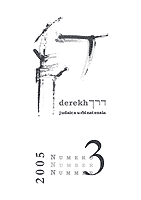
We kindly inform you that, as long as the subject affiliation of our 300.000+ articles is in progress, you might get unsufficient or no results on your third level or second level search. In this case, please broaden your search criteria.

Ideea conceperii unei analize de scurte dimensiuni, făcute cu instrumentele teoriei literare şi aplicate la proza memorialistică aparţinând unei supravieţuitoare a Holocaustului, mi-a venit atunci când am văzut reacţia unor profesori de istorie prezenţi la sesiunea de instruire privind predarea problemei Holocaustului – aşa cum a fost – fără patimi şi fără prejudecăţi. Prima reacţie, de obicei şi cea mai necenzurată, a fost aceea de a respinge fără rezerve aspectele dure ale expunerilor, mai ales când a venit vorba despre atrocităţile comise împotriva evreilor în Transnistria, în timpul guvernării generalului Antonescu
More...
The Holocaust in Mures County as seen in the media of the time.
More...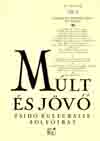
Neha megpóbálom elképzelni a sokat tapa,ztalt vámtiszt arcát, miután kinyittatta Böröcz András bőröndjét ... Néha megpróbálom megérteni, miért csinál ez az ember - Böröcz - hordozható, olykor hangszer módjára szétszedhető és tokba helyezhető szobrokat. Vajon csupán azért, mert úgy él, ahogyan? Azért, mert ez az életforma, ez a művészi egzisztencia némiképp emlékeztet egy vándorkereskedőére ? Az is foglalkoztat, mivégre ez az előbbi meggondolásból fölöttébb célszerűtlen és nem is csak ironikus vonzalom az emlékmű súlyosan kompromittált műfaja iránt. A kérdés most már megkerülhetetlen.
More...
A kiállításra érkezőt egy hatalmas diptichon fogadja, egy női és egy férfiarc, alig-alig felismerhetően, mintha a vászon furcsán meggyûrődött volna, talán a festés előtt, de az is lehet, hogy utána. A két portré tekintete keresztezi egymást. Ez szinte arra ösztönzi a látogatót, hogy álljon be ebbe a keresztezési pontba. Ezzel az invitálással fogadja (a művész és a kurátor) a kiállítás a látogatóit. Te, aki itt belépsz, egy életműkiállítással találkozol, Valkó László kaposváribudapesti- pécsi festőművész és grafikus kiállí - tásával.
More...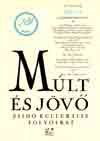
Az emberekből-legalábbis sokukból- erős érzelmeket váltanak ki azok az események, amelyek valamiképpen érintik az eredetüket. A közel-keleti válságok mélyebben megrendítenek minket, mint a másutt (például Mrikában vagy Peruban) zajlók; az előbbiek hatása az egész bolygóra kiterjed. Mintha a kőolajon kívül itt volna egy kozmikus, égi és földi gépezet energiaforrása is, melyet a három egyistenhit - a zsidó vallás, a kereszténység és az iszlám -táplál, melyek összecsapnak, zavarják, átfedik és keresztezik egymást - az isteni indíttatás és az emlékezet, az identitás és annak elvesztése jegyében.
More...
Téves értelmezés? Mi a mondás valódijelentése? Nem az érzés számít: a tett
More...
Teoria conspiraţiei evreieşti pentru a domina lumea este o formă de a crea ţapi ispăşitori colectivi din evrei, când de fapt este doar o expresie socială a frustrărilor legate de modernizare şi impunerea pronunţată a principiilor pieţei în variate domenii ale societăţii şi relaţiilor sociale. Timp de secole, creştinii din Europa au avut o atitudine discriminatorie faţă de evrei. Pentru mulţi dintre ei prejudecata împotriva evreilor îmbrăca forma anti-semitismului. Împiedicaţi să posede şi să lucreze pământul, evreii au exercitat înca din epoca medievală un evantai de profesii, cuprinzând mai ales micul meşteşug, medicina, negoţul si împrumutul. Împrumutul cu dobândă, numit camătă, a fost rezultatul unei politici deliberate a Bisericii. Camăta face obiectul condamnarilor celor mai categorice, printre cele ce nu admit nici excepţii şi nici circumstanţe atenuante. Dacă evreul a devenit arhetipul cămătarului mârşav, aceasta s-a datorat antiiudaismului ecleziastic, ducând la figura lui Iuda Iscariotul, trădator pentru 30 de arginţi. Articolul arată cum evreii, care n-au trăit nicicând din funcţii de stat, nici din agricultură, au transformat viaţa bănească – integrarea comercială, meşteşugărească – în arena libertăţii şi emancipării lor.
More...
“1. Birobidzhan Birobidzhan, “paradisul” destinat evreilor din URSS de către autorităţile sovietice în anii 1930, este regiunea străbătută de râurile Biro şi Bidzhan, o zonă izolată şi puţin populată din Extremul Orient, lângă graniţa chino-sovietică, la aproximativ 10.000 de km de Moscova. În acestă zonă regimul comunist a stabilit formal din 1934 - primii colonişti evrei au sosit încă din 1928 - “Patria evreimii sovietice”, sau, conform limbajului oficial, Regiunea Autonomă Evreiască (RAE). După Revoluţia din 1917, care a abolit sistemul ţarist de discriminare a evreilor, comuniştii au căutat să rezolve “problemele” evreilor din URSS precum sărăcia, naţionalismul evreiesc, influenţa prea mare a religiei, etc. prin intermediul”[…]
More...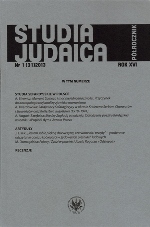
The aim of this article is to present a new anthropological interpretation of secular trends among the marranos of the sixteenth and seventeenth century. Referring to Mary Douglas’ concept of impurity and to Victor Turner’s notion of liminality as well as to some historical records on the marranos’ way of life and their religiosity, the author shows that the marrano, torn apart between the Jewish and Christian worlds, is placed beyond the accepted and unambiguous social categories and therefore perceived as a threat to social order. In the second part of the article examples of skeptical, rational or even atheist marrano attitudes are analyzed. A special emphasis was placed on the philosophical work of Baruch Spinoza who proposes in his Tractatus theologico-politicus a secular vision of a state based on tolerance and freedom of speech. Spinoza’s efforts are shown as a marrano rationalist’s struggle to overcome the “marrano condition,” i.e. a condition of people forced to live on the margin of society due to their hybrid status. The new secular identity can be therefore understood as a response to unresolved conflicts generated by the social position of the marranos.
More...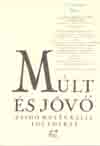
1922 márciusában egy labdarúgót megvertek Debrecenben. Az eset önmagában nem lenne figyelemre méltó, a háború, a forradalmak és az éppen elhalkult várospolitikai harc mellett, egy ilyen elszigetelt, spontán erőszakos akció nem keltett különösebb feltűnést. Emellett nyílt erőszakkal a futballpályán már korábban találkozhattak a debreceniek, 1920 júliusában az egyik mérkőzésen "a közönség a pályára hatolt, s ott a játékosokat, valamint a rendet fenntartani igyekvő rendőröket is insultálta." A fentebb említett incidens a Debreceni Egyetemi Atlétikai Club és a Debreceni Torna Egylet csapatai lk.özött lezajlott mérkőzés után történt, a találkozÓ< alatt folyamatosan zsidózó egyetemisták megve1cték a DTE játékosát, Róthot. Az eset azért különösen figyelemre méltó, mert a játékos zsidó volta miatt kapta az ütéseket, és nem azért, mert a konkurens egyesületben futballozott.
More...